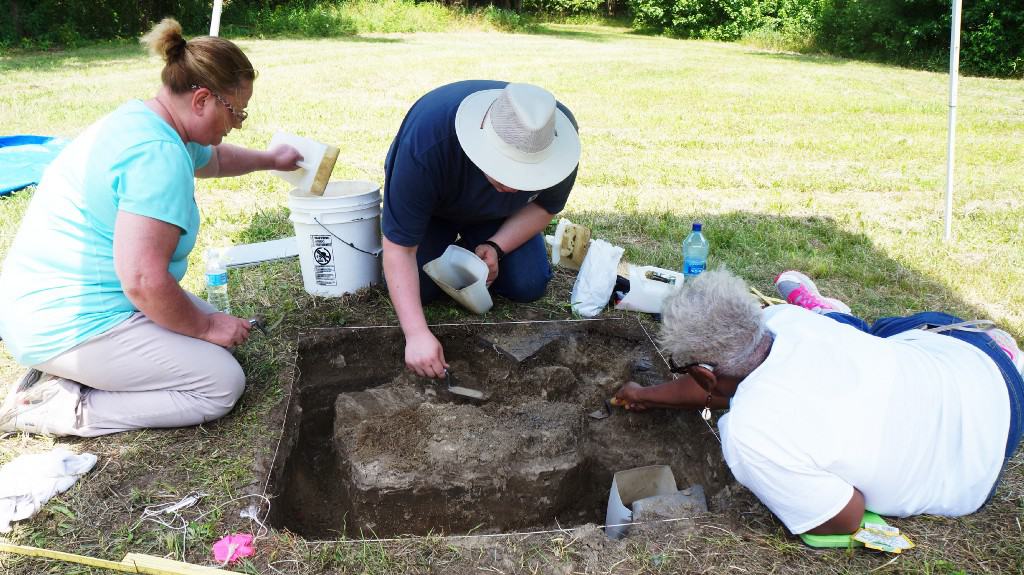
Ph.D candidate and volunteers dig for artifacts at the site where Dr. James Still’s Medford home once stood
So far they’ve found a number of smoking pipe stems, a penny from 1895 and a coal stove made in 1868.

Ever since his advisor at Monmouth University told him about Dr. James Still, Marc Lorenc was hooked.
“The whole idea of this uplifting narrative of his parents being formally enslaved to [becoming] a wealthy landowner in Medford is just a fantastic story,” Lorenc, who earned his master’s degree in anthropology from Monmouth in 2013, said. He earned his bachelor’s degree in history from New York’s Bard College in 2009 and is working on his Ph.D. at University of Massachusetts in anthropology.
“To figure out why it resonates with so many different people is what got me into it,” he added.
The dig at the site of Still’s former house is part of his dissertation for his Ph.D.
Still was a wealthy landowner who lived in Medford. He lived from 1812 to 1882. Still was a herbalist and holistic doctor, differentiating himself from other doctors of the time period, who would frequently use poisons such as mercury to treat people for various illnesses, according to Lorenc. Needless to say, the mercury “treatment” many doctors used ended up killing people.
Whether Still’s methods of herbalistic and holistic medicine succeeded in curing illnesses is up for debate. However, Still is celebrated for at least not using poisons to treat illnesses, which, during a time when not much was known about medicine, is no small feat.
More importantly, he is celebrated for being the epitome of the American Dream. As Lorenc noted, Still was a black man born to enslaved parents. He taught himself how to read and write and eventually became a doctor — all while only having three months of formal schooling, according to the Medford Historical Society’s press release.
The site of Still’s house is at 209 Church Road, which was located next door to his office. His office is still standing to this day, although it’s decrepit and unsafe to go inside.
To date, Lorenc and his volunteers have found some pretty cool things. They’ve found a bunch of smoking pipe stems, an Indian Head Penny dated from 1895 and a chamber pot from the 1840s.
The Indian Head Penny made in 1895 is a mystery to Lorenc because Still only lived until 1882.
But chief among all of the artifacts they’ve found is a coal stove made in 1868 in Philadelphia.
“That was in the foundation layer in the corner of the house that we dug up last year,” Lorenc said. “That’s why we’re digging it up again because there’s more there about what will tell us.”
Lorenc knows there’s more in the foundation layer than just the coal stove because last year he conducted a geophysical survey to find out where objects are underground.
“It showed us … what’s still there that we can [dig] up,” he said. “We’re using that to base our excavations on. Last year we exposed part of the corner foundation of the house that was built in the 1860s and got demolished in 1932. So we’re trying to recover what’s left of it and trying to learn a little bit more about the construction of the house and what kind of artifacts were present at the house.”
The day The Sun went to report on the dig, Lorenc had seven volunteers with him, all of whom were enthusiastic about the project.
“I’m interested in how race and medicine and illness can interact in health,” said Jacob Demree, who’s a medical anthropology student at Swarthmore. “I found out about this project regarding Dr. Still and thought it would be a neat way to delve deeper and try a different approach about that same topic by looking through the past because the artifacts do tell stories. People tell stories, but the artifacts tell them in a different way.”
“Where I’m born and raised you still hear things about the revolutionary war,” said Charles Burns who’s a retired engineer and former adjunct professor at Rowan College. “I’ve also seen a lot of history being destroyed. It’s happening every day with large developments. These farmhouses go under. And then what’s even worse is you don’t even know where the foundation is because they’ll go back and destroy everything. So we’re losing our history.”
“You look at satellite pictures and see foundations that are hundreds or thousands of years old,” Burns continued. “This is a golden opportunity to come and look firsthand.”
Lorenc and his volunteers work every day from 8 a.m. to 2 p.m. with Sundays and Mondays off. The team will be digging from now until Aug. 6. Those interested in volunteering can contact Lorenc at [email protected].









